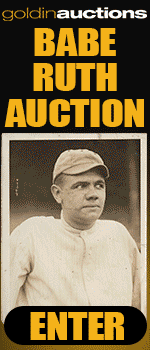2. Two 1913 Playing Card Sets Challenge Today's Collectors
Two closely related playing card sets produced in 1913 have a unique attraction among many of today's vintage collectors. Both were "invented" by Thomas H. Barker and produced by the National Baseball Playing Card Company, Inc. of Boston. They are designated by collectors as the WG5 "National Game" and the WG6 "Tom Barker Game" (see Notes on "WG" Nomenclature below).
The cards are somewhat scarce but available, with common players in VG condition generally selling in the $20-$30 range.
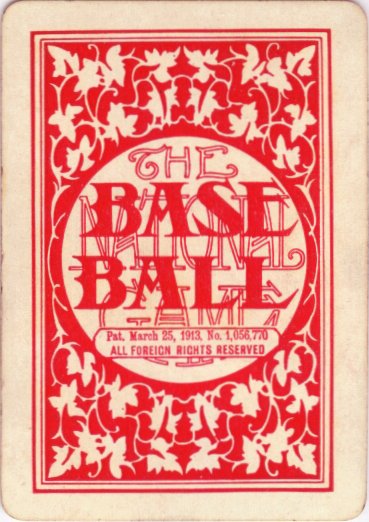
WG5 National Game Back |
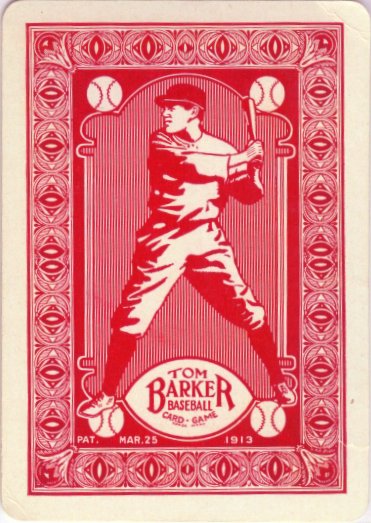
WG6 Tom Barker Back |
The two sets are largely the same but with notable differences.
Perhaps the most distinctive difference between the two sets is in the card backs (examples shown at right). As seen, both are framed in an ornate red background pattern.
Both games contain 52 playing cards in addition to a score card and a folded instruction sheet. The cards are standard playing card size (2-1/2 by 3-1/2 inches) and were distributed as sets in cardboard boxes that sold for 50 cents each.
Of the 52 playing cards, 43 feature images of named baseball players of the period. The remaining nine cards show generic action scenes without identifying the players depicted in the scenes.
A patent notice dated March 25, 1913 is printed in small type on the card backs from both sets.
The National Game backs (above left) are labeled as such inside a large round panel. The Tom Barker card backs (above right) are quite different and display a left-handed batter in full body pose and further decorated with a small baseball in each corner.
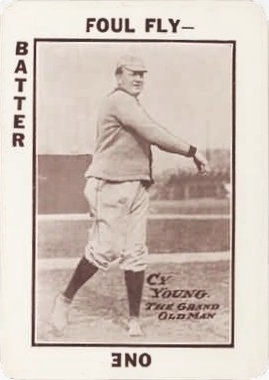
Cy Young
WG5 National Game |
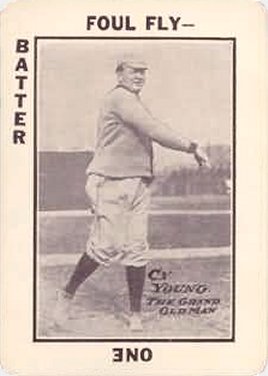
Cy Young
WG6 Tom Barker Game |
Of the 43 cards in each set with identified players, 38 players are identical and common to both the "National" and the "Barker" card game sets (an example of the Cy Young card from each set is shown at left).
These 38 cards use not only the same player images, but also display the same baseball "actions" used for playing the card game.
There are five cards, however, that are unique to each set. For the WG5 National Game set, these cards are: Chase (N.Y. Amer.); Dahlen (Brooklyn); McLean (St. Louis, Nat.); Stahl (Boston, Amer.) and Stovall (St. Louis, Amer.).
The five cards unique to the WG6 Tom Barker game include Carrigan (Boston Am.); Chase (Chicago Am.); Meyers (N. Y. Nat.); Wheat (Brooklyn Nat.) and Wingo (St. Louis Nat.).
Note: see Player Checklist for a complete listing of all cards in both sets.
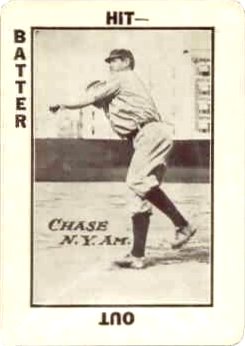
Chase, N.Y. Am.
1913, first 39 games
WG5 National Game |
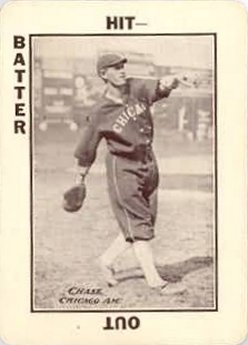
Chase, Chicago Am.
1913, final 102 games
WG6 Tom Barker Game |
As indicated, all but one of the five cards that are unique to each game depict entirely different players. The one exception is the card for Hal Chase, who is represented in both sets--but with a different pose.
The Chase cards from the two sets also list a different team affiliation that reflects his move from the New York American League to the Chicago American League after 39 games into the 1913 season. Chase then played in over 100 games that season for Chicago (see change in pose on the Chase card from the examples at right).
From this change, it seems clear that the Barker Game was produced and distributed later in the year, despite the March 25, 1913 patent date found on the backs of both card sets.
A box in which the National Game cards were distributed is shown here.
A Combined Checklist for the WG5 and WG6 game card sets has been added to the Old Cardboard website along with a full Gallery for the WG5 National Baseball Game set.
Note: the rules for playing the National Game and the Barker Game are the same, although the instructions found in the Barker Game provide a little more detail.
The WG6 instructions are provided on the Old Cardboard website on the profile page for the WG6 Tom Barker Card Game.
Notes on "WG" Nomenclature: The WG5 and WG6 designations are often attributed to the American Card Catalog. Curiously, however, the WG designation in the ACC (1960) is reserved for "Greeting Cards" with the lower numbers (WG1 through WG50) used more specifically for Valentine cards. The WG designation as applied to baseball-themed playing cards was apparently first used in the late 1970s in the Sports Collectors Bible under the general heading "Team Games."


